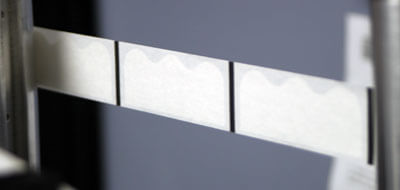TECHNOTE LT04-0042
Copyright © 2015 Lion Precision. www.lionprecision.com
Summary
When TechniPac Inc. installed a clear-label sensor for less than $800, their customer no longer had to pay for eyemarks on the label web. That saved them nearly $8,000 on the first label order – $15,000 in less than a year.
A three-minute video summary featuring Interviews with the study’s participants is below:
Clear Label Sensing with Eyemarks

TechniPac Inc. is a flexible packaging converter. Greg Melchoir, VP of Sales describes TechniPac as “specializing in solving problems.” One product involves the application of a clear label to a flexible pouch. The Label-Aire labeler had a traditional optical (photo-eye) label sensor which could not see the clear edges of the clear label. To solve this problem, they had Rebs Marketing, their label supplier, add a black “eyemark” to the release liner – a black bar the width of the liner that triggers the photo-eye.
That solved the sensing problem, but added additional stages to the printing process including flipping the web over with a turn-bar. That requires that the process run much more slowly than it could otherwise. Large orders could take days instead of hours, and that costs money.
Clear Label Sensors – No Eyemarks Required
Mark Kretschmar of Lion Precision was speaking to Brian Baker of Rebs Marketing about clear label sensors when Baker mentioned TechniPac as a possible site for a cost-savings experiment. Melchoir agreed and installed an LRD6110 clear label sensor and Baker started providing labels without eyemarks. The first order of labels (2.3 million labels) saved $7,600. The labels are ordered about every six months resulting in an annual savings of over $15,000. The list price of a clear label sensor (LRD6300) is only $795. Melchoir added, “The sensor has been working great ever since we started with it last May.”
Baker said, “We’re always trying to save our customers money, but I’ve never saved a customer that much with just one adjustment to a process.”
Adding to the Bottom Line
“I’m always surprised at the number of people still using eyemarks. It just doesn’t make sense anymore. Clear label sensors have been around since the mid 1990s,” says Kretschmar. He adds, “People still paying for eyemarks for label registration on clear labels are missing a real opportunity to add significantly to the bottom line.”
Clear label sensors were introduced in 1993 and used capacitive sensing technology which uses electric fields instead of light. The electric fields detect thickness changes and are not affected by color or transparency. The LRD6110 has since been replaced by the LRD6300 which features pushbutton AutoGap setup and a lower price.
Label Sensor Options
| 8200 | 6300 | 2100 | |
| Application | |||
| Clear Labels | • | • | • |
| Paper labels | • | • | • |
| Solid foil/metal labels | • | • | |
| Metallic artwork, printing or stamping | • | • | |
| Splices | • | • | • |
| Rewinders | • | • | • |
| Specifications | |||
| Response Time | 425 µs | 20 µs | 20 µs |
| Maximum Switching Speed | 1 kHz | 10 kHz | 10 kHz |
| Accuracy | 0.3 mm | 0.4 mm | 0.2 mm |
Features |
|||
| Technology | Ultra Sonic |
Cap. | Cap. |
| Adjustments | Button | Button | Screw |
| Bar Graph Display | • | • | |
| Selectable Light/Dark Switching | Button | Button | Wired |
| Wide Fork (3 mm / 0.12″) | • | ||
| NPN and PNP Outputs | • | • | • |
